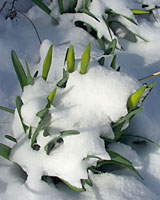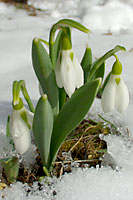Terry L. Ettinger Horticulture Consulting Services
Meeting The Needs Of Today With A Vision For The Future
Question of the Week
Bulb Foliage and Snow
 Q. I’m afraid that the cold and snow has ruined the 500 daffodils that I planted last fall. Many of them have
started to come up and are now covered with snow! Do you think they’ll survive and bloom?
Q. I’m afraid that the cold and snow has ruined the 500 daffodils that I planted last fall. Many of them have
started to come up and are now covered with snow! Do you think they’ll survive and bloom?
A. This is a very common question from the time the first snowdrops appear between mid-February and mid-March right through the last snowfall of the season which can be as late as Mother’s Day - or (shudder), even later!
 The good news is that there’s absolutely no reason for concern.
In fact, I think some spring-flowering bulbs such as winter aconite
and snowdrops (at left) are absolutely stunning when they pop up
through the snow!
The good news is that there’s absolutely no reason for concern.
In fact, I think some spring-flowering bulbs such as winter aconite
and snowdrops (at left) are absolutely stunning when they pop up
through the snow!
First, the growing point of spring-flowering bulb and bulb-like plants are located at least several inches beneath the soil surface where temperatures are still well above freezing despite the recent cold spell.
Also, most of our common spring-flowering bulbs are native to gravelly pockets of soil in the mountainous regions of southern Europe, northern Africa and throughout Eurasia (Turkey, Iran, Iraq, Afghanistan, etc.) at elevations of 8,000 to 10,000 feet and higher! Many species of daffodils (Narcissus), for example, originated in the mountains of Portugal, Spain, Algeria and Morocco and are therefore very well-adapted to the kind of weather we’ve experienced during the past couple of weeks.
In fact, the relatively wet, warm summer weather that's typical of Central New York is a greater risk to your daffodils than is our normally cold, snowy winters – especially if bulbs are planted in heavy, poorly drained clay soils. In these situations the bulbs, which prefer to be very dry when dormant, become susceptible to a variety of decay organisms.
Therefore, in the future, make sure to plant your bulbs only in those areas that have very well-drained – even dry - soils and receive as much direct sunlight in the spring as possible.